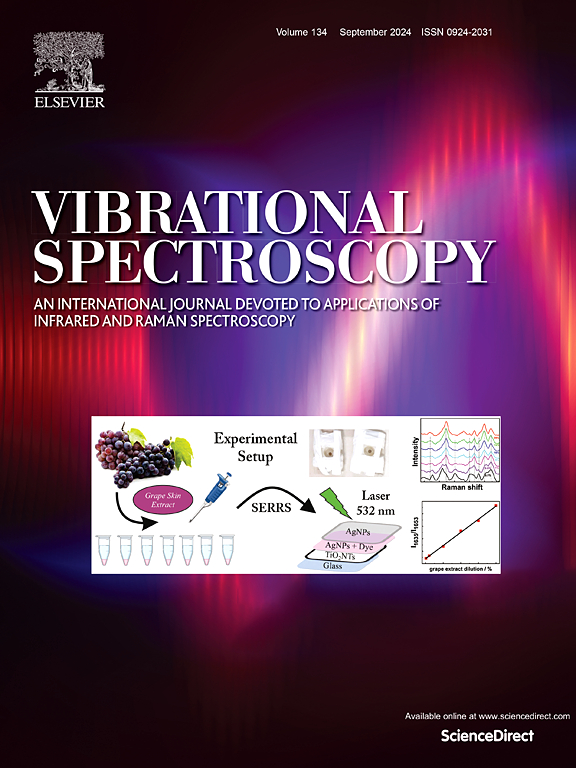Imazamox除草剂致葱模型系统改变的光谱和遗传毒性评估
IF 3.1
3区 化学
Q2 CHEMISTRY, ANALYTICAL
引用次数: 0
摘要
Imazamox (IMA)是一种咪唑啉酮类除草剂,通常用于控制向日葵、豆类、豌豆和鹰嘴豆等作物的杂草。本研究利用衰减全反射-傅里叶变换红外(ATR-FTIR)光谱和遗传毒性试验,在分子水平上研究了24 h暴露于不同浓度的IMA(125、250和500 ppm)对洋葱根尖的影响。ATR-FTIR结果表明,所有剂量的IMA均引起脂质过氧化水平升高,组织代谢活性降低,蛋白质、碳水化合物和核酸含量降低,饱和脂质含量增加。此外,IMA引起了重要的结构修饰,包括缩短脂链,减少膜的无序性和流动性,增加羰基含量和脂蛋白比。主成分分析(PCA)和层次聚类分析(HCA)通过有效区分不同剂量的对照组和ima治疗组,证实了这些光谱变化。遗传毒性实验进一步表明,IMA诱导了A. cepa根尖的各种有丝分裂异常,如c-有丝分裂、不规则中期和微核形成。观察到的结构和基因毒性变化明显是剂量依赖性的,浓度越高,影响越严重。这些发现强调了与IMA暴露相关的潜在风险,并建议在使用这种除草剂时应更加谨慎。此外,ATR-FTIR光谱技术在除草剂诱导的分子变化检测中的成功应用表明,该技术与化学计量学和a . cepa作为生物指标模型系统相结合,为农药毒性评价提供了一种快速可靠的生物监测工具。本文章由计算机程序翻译,如有差异,请以英文原文为准。
Spectroscopic and genotoxic assessment of Imazamox herbicide-induced alterations in the Allium cepa model system
Imazamox (IMA), an imidazolinone herbicide, is commonly used to control weeds in crops such as sunflower, beans, peas and chickpeas. In the current study, the effects of 24 h exposure to different IMA concentrations (125, 250, and 500 ppm) on Allium cepa root tips were investigated at molecular level using Attenuated Total Reflection-Fourier Transform Infrared (ATR-FTIR) spectroscopy and genotoxicity tests. The ATR-FTIR results indicated that all doses of IMA caused an increase in lipid peroxidation levels and a decrease in tissue metabolic activity, along with a decrease in protein, carbohydrate and nucleic acid content and an increase in saturated lipid content. In addition, IMA caused important structural modifications including shortened lipid chains, reduced membrane disorder and fluidity, increased carbonyl content and lipid to protein ratio. Principal component analysis (PCA) and Hierarchical cluster analysis (HCA) confirmed these spectral alterations by effectively distinguishing control and IMA-treated groups across different doses. Genotoxicity assays further demonstrated that IMA induced various mitotic abnormalities, such as c-mitosis, irregular metaphase and micronuclei formation in A. cepa root tips. The observed structural and genotoxic changes were clearly dose-dependent, with higher concentrations causing more severe effects. These findings highlight the potential risks associated with IMA exposure and suggest that more caution should be exercised in the use of this herbicide. Furthermore, the successful application of ATR-FTIR spectroscopy to detect herbicide-induced molecular changes suggests that this technique, combined with chemometrics and A. cepa as a bioindicator model system, offers a rapid and reliable biomonitoring tool to evaluate pesticide toxicity.
求助全文
通过发布文献求助,成功后即可免费获取论文全文。
去求助
来源期刊

Vibrational Spectroscopy
化学-分析化学
CiteScore
4.70
自引率
4.00%
发文量
103
审稿时长
52 days
期刊介绍:
Vibrational Spectroscopy provides a vehicle for the publication of original research that focuses on vibrational spectroscopy. This covers infrared, near-infrared and Raman spectroscopies and publishes papers dealing with developments in applications, theory, techniques and instrumentation.
The topics covered by the journal include:
Sampling techniques,
Vibrational spectroscopy coupled with separation techniques,
Instrumentation (Fourier transform, conventional and laser based),
Data manipulation,
Spectra-structure correlation and group frequencies.
The application areas covered include:
Analytical chemistry,
Bio-organic and bio-inorganic chemistry,
Organic chemistry,
Inorganic chemistry,
Catalysis,
Environmental science,
Industrial chemistry,
Materials science,
Physical chemistry,
Polymer science,
Process control,
Specialized problem solving.
 求助内容:
求助内容: 应助结果提醒方式:
应助结果提醒方式:


